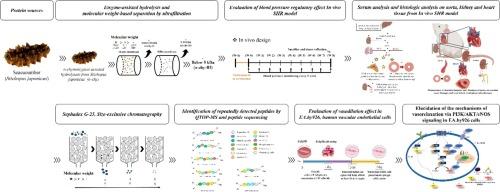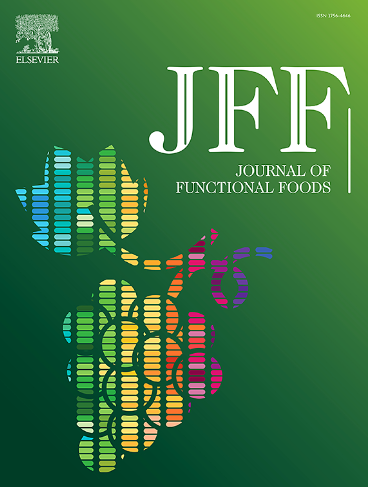Potential blood pressure regulatory effect of low molecular weight α-chymotrypsin extract and its peptides from Stichopus japonicus: Peptide-ACE interaction study via in silico molecular docking
IF 3.8
2区 农林科学
Q2 FOOD SCIENCE & TECHNOLOGY
引用次数: 0
Abstract
Hypertension is a significant risk factor for cardiovascular disease and heart damage. Stichopus japonicus (S. japonicus) is a red sea cucumber with antioxidant and anti-hypertensive activities. However, its anti-hypertensive mechanism remains unclear. In this study, we evaluated the inhibitory effects of angiotensin-converting enzyme (ACE) of α-chymotrypsin-assisted hydrolysate of S. japonicus (α-chy) and its ultrafiltrate fractions (>10 kDa [α-chy-I], 5–10 kDa [α-chy-II], and <5 kDa [α-chy-III]). Low molecular α-chy-III exerted excellent ACE inhibitory and anti-hypertensive activities in spontaneously hypertensive rats (SHR). Moreover, α-chy-III significantly reduced the systolic and diastolic blood pressure by modulating the serum angiotensin and ACE levels. Histological analysis revealed that α-chy-III markedly protected the aorta, heart, and kidney tissues of SHR from hypertension-induced tissue damage.
Taken together, our findings highlight the potential of α-chy-III as a functional food ingredient for the treatment of hypertension and its comorbidities.

从日本螫虾中提取的低分子量α-糜蛋白酶及其多肽的潜在血压调节作用:通过硅学分子对接进行肽-ACE相互作用研究
高血压是心血管疾病和心脏损伤的重要风险因素。日本刺参是一种具有抗氧化和抗高血压活性的红海参。然而,其抗高血压机制仍不清楚。在这项研究中,我们评估了日本刺参的α-糜蛋白酶辅助水解物(α-糜)及其超滤液组分(10 kDa [α-chy-I], 5-10 kDa [α-chy-II], and <5kDa[α-糜-III])对血管紧张素转换酶(ACE)的抑制作用。低分子 α-chy-III 对自发性高血压大鼠(SHR)具有极佳的 ACE 抑制和抗高血压活性。此外,α-chi-III 还能通过调节血清血管紧张素和 ACE 水平,显著降低收缩压和舒张压。组织学分析表明,α-chi-III 能明显保护 SHR 的主动脉、心脏和肾脏组织免受高血压引起的组织损伤。
本文章由计算机程序翻译,如有差异,请以英文原文为准。
求助全文
约1分钟内获得全文
求助全文
来源期刊

Journal of Functional Foods
FOOD SCIENCE & TECHNOLOGY-
CiteScore
9.60
自引率
1.80%
发文量
428
审稿时长
76 days
期刊介绍:
Journal of Functional Foods continues with the same aims and scope, editorial team, submission system and rigorous peer review. We give authors the possibility to publish their top-quality papers in a well-established leading journal in the food and nutrition fields. The Journal will keep its rigorous criteria to screen high impact research addressing relevant scientific topics and performed by sound methodologies.
The Journal of Functional Foods aims to bring together the results of fundamental and applied research into healthy foods and biologically active food ingredients.
The Journal is centered in the specific area at the boundaries among food technology, nutrition and health welcoming papers having a good interdisciplinary approach. The Journal will cover the fields of plant bioactives; dietary fibre, probiotics; functional lipids; bioactive peptides; vitamins, minerals and botanicals and other dietary supplements. Nutritional and technological aspects related to the development of functional foods and beverages are of core interest to the journal. Experimental works dealing with food digestion, bioavailability of food bioactives and on the mechanisms by which foods and their components are able to modulate physiological parameters connected with disease prevention are of particular interest as well as those dealing with personalized nutrition and nutritional needs in pathological subjects.
 求助内容:
求助内容: 应助结果提醒方式:
应助结果提醒方式:


